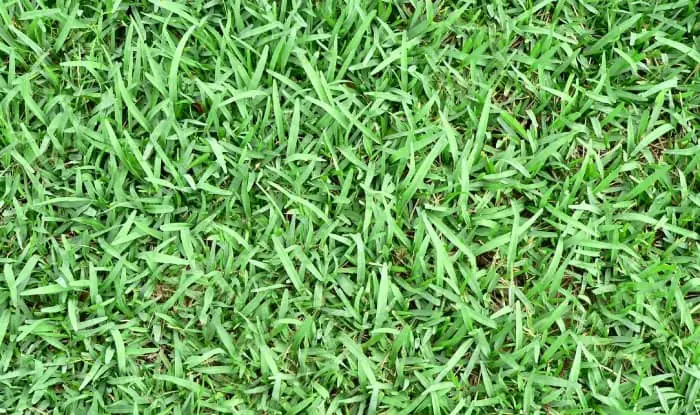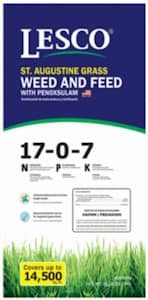St. Augustine is a popular lawn grass, but it can be difficult to take care of.
Fertilizer will help it to grow green and strong. But so will the weeds.
And most weed killers will cause it harm.
But fortunately, there’s an easy solution.
Using the best weed and feed for St. Augustine grass allows you to combine an effective fertilizer with a powerful herbicide that won’t damage your lawn.
My recommended choice is Scotts Turf Builder Bonus S Southern Weed & Feed.
You can use this popular product to kill a wide range of common lawn weeds, with pre-emergent and post-emergent control. While the high nitrogen fertilizer will quickly green up your lawn and encourage strong and healthy growth.
The top choices at a glance:
All links lead to Amazon, where you can find more information & customer reviews.
The Best Weed And Feed For St. Augustine Grass: Reviews
Scotts Turf Builder Bonus S Southern Weed & Feed
Scotts is a popular brand that’s well respected for its line of lawn care products. This weed and feed is specially formulated for use on southern lawns. It’s safe to use on St. Augustine grass, including the Floratam variety that other products sometimes harm.
It’s very effective at controlling a wide range of common lawn weeds, including clover, dollarweed, dichondra, chickweed, and many more.
It contains a herbicide called atrazine, which is found in many of the best weed killers for St. Augustine grass.
Atrazine works as a post-emergent that kills the weeds already growing on your lawn. And it also has the added benefit of acting as a pre-emergent that can prevent weeds from germinating and growing.
The fertilizer has an NPK ratio of 29-0-10. With plenty of nitrogen for fast and green growth. And potassium for healthy grass development and to withstand disease. It also contains the important secondary nutrient sulfur.
As well as St. Augustine, you can also use it on centipedegrass, zoysiagrass, and carpetgrass.
It comes in 2 different-sized bags of granules with enough to treat 5,000 and 10,000 sq. ft. of lawn. After applying the granules, you immediately water them so they can start to take effect.
You can get it in a standard version and one for Florida.
Ferti-Lome St. Augustine Weed and Feed
Next up on my list is this high-quality weed and feed by Fertilome.
Similar to the product above, it contains the herbicide atrazine. This is good for killing a wide range of broadleaf weeds. Including dandelion, henbit, creeping charlie, dollarweed, chickweed, stinging nettle, and Florida betony.
And it can also be used as a pre-emergent to control problematic grassy weeds and sedges when applied at the right time of year. Examples include crabgrass, paspalum, and yellow nutsedge.
It contains fertilizer with an NPK ratio of 15-0-4. And it’s fortified with a number of secondary nutrients and micronutrients such as copper, boron, manganese, iron, and zinc. This helps to provide the optimal nutrition for strong and healthy growth of your grass.
The granules come in a 16-lb bag that can be used to treat 2,500 sq. ft. of lawn.
Scotts Turf Builder Southern Triple Action
Scotts Turf Builder Southern Triple Action is a good choice for killing weeds and fertilizing your lawn.
But that’s not all:
Because the 3 in 1 product also kills insects and prevents them returning for 6 months. Making it an excellent choice if you struggle with fire ants, sod webworms, armyworms, mold crickets, and fleas.
But you need to have a bit of patience when using it. Although it’s very effective, you often have to wait a few weeks for the full results of the weed killer and insecticide to appear. And sometimes a second application after 8 weeks is needed for well-established weeds.
The herbicide it contains is atrazine, which gives you control of a variety of common lawn weeds. And it contains bifenthrin to kill the insects. But as this is highly toxic to aquatic organisms, you should be careful about using it near ponds, streams, and waterways.
The fertilizer it contains has a 29-0-10 NPK ratio that’s good for building strong lawns.
The product is designed for use on specific grass types that are commonly used for southern lawns. You can use it on:
- St. Augustine grass
- Zoysiagrass
- Centipedegrass
- Carpetgrass
It’s a granular weed and feed that’s easy to spread with a broadcast spreader. The bag comes in 2 sizes: a large one covering 8,000 sq. ft. and a smaller size that can treat 4,000 sq. ft.
BioAdvanced 3 In 1 Weed & Feed For Southern Lawns
BioAdvanced Weed And Feed combines post-emergent and pre-emergent properties. Keeping grassy and broadleaf weeds away for up to 6 months at a time.
It contains 2 post-emergent herbicides, penoxsulam and dicamba, that control broadleaf weeds and grasses. They act as systemic herbicides that kill weeds to the root.
It also contains indaziflam, a pre-emergent herbicide that prevents weed seeds from germinating and gives residual control in the treated area for months after.
It’s recommended for use in the spring and in the fall so you can control weeds such as crabgrass, Poa annua, chickweed, clover, dollarweed, dandelion, and nutsedge.
And when you’re applying it to a lawn of weeds it’s best to do it early while they’re still growing, before they become mature.
It’s designed for use on southern turfs and is safe to use on established St. Augustine grass lawns including Floratam.
You can also use it on:
- Bermudagrass
- Zoysiagrass
- Centipedegrass
The fertilizer has a 35-0-3 NPK ratio. With a 50% slow-release formula. So you get nitrogen released quickly for rapid growth and greening. But it also continues to provide nutrients in the following weeks.
The 12.5 lbs bag contains enough granules to cover 5,000 sq. ft.
Lesco Weed & Feed For St Augustine Grass
This weed and feed by Lesco is specially formulated for use on St. Augustine grass including the Floratam variety.
It controls weeds using the herbicide penoxsulam. This systemic weed killer kills weeds all the way down to the root, preventing them from regrowing again. But it can take a couple of weeks for the weeds to die. So you need a bit of patience to wait for the results.
It contains 17-0-7 NPK fertilizer to green up your lawn quickly.
The 50-lb bag can be used to cover 14,000 sq. ft.
Vigoro Weed & Feed Lawn Fertilizer Weed Control

Vigoro Weed And Feed kills over 200 common weed species.
The fertilizer is high-nitrogen, with an NPK ratio of 29-0-3. Containing fast-release nitrogen that results in your lawn visibly greening up within 72 hours. And it also contains time-released nitrogen that’s slowly released into the soil.
This provides continuous feeding over the following 2 months. And helps to make sure that your lawn doesn’t get burnt from taking up too much fertilizer in too short a space of time.
It’s recommended to apply it while the weeds are actively growing. And some customers report inconsistent results when applying it to mature plants.
You can use this weed and feed fertilizer all season. And it’s safe to use around flower beds and landscaping.
The 7 lb container of granules is enough to treat 2,500 sq. ft.
Sunniland St. Augustine Weed And Feed
Sunniland Weed And Feed contains atrazine to give it post-emergent and pre-emergent control of a range of broadleaf and grassy weeds. Such as spotted spurge, crabgrass, pigweed, and Florida pusley.
You can safely use it on the following grass types:
- St. Augustine
- Centipede
- Zoysia
But if your lawn is newly seeded you’ll have to wait for 8 weeks before applying it.
The fertilizer has a 20-0-6 NPK formula, with 50% slow release to fertilize your lawn for up to 90 days.
Use it in the fall, winter, and spring for the best results. But it’s not recommended for use during the hot summer months.
The granules come in a 20-lb bag that can be used to cover 5,000 sq. ft.
Choosing The Best Weed And Feed For St. Augustine Grass
With so many weed and feed products available on the market, how do you choose the right one?
Here are some things to consider:
Emergence
Pre-emergent herbicides work by preventing weed seeds from germinating in the soil. But to do this you have to apply them at the right time of year. Usually in early spring and late fall.
Pre-emergent herbicides are an effective way of stopping lawn weeds that spread by seed. But you need to plan ahead of time, because if they’re already growing it won’t work. To control weeds that are growing you need a post-emergent herbicide.
Some weed and feed brands contain herbicides that give you both pre-emergent and post-emergent control.
Granules Or Spray
Weed and feed is most commonly available in granules. But you can also get it in a spray.
Granules have the advantage that they’re easy to spread evenly over your lawn so that every area gets the same amount. But to do this you need to have a spreader.
Liquid spray often comes in a bottle of concentrate that can be attached to your hose and then sprayed over your lawn.
This is quick and easy to do, but it’s harder to get even coverage of the grass.
The best products currently available are granular in my opinion. This is probably because there are a lot more of them around to choose from that are safe for St. Augustine grass.
But if you like the convenience of a liquid spray here is one for you to consider you can use on St. Augustinegrass (but not Floratam):
Spectracide Weed & Feed Ready To Spray
Final Thoughts
You have to be careful when choosing a good weed and feed for St. Augustine lawns as many of the most popular products on the market can cause harm to your grass.
My choice of the best weed and feed for St. Augustine grass is Scotts Turf Builder Bonus S Southern Weed & Feed. It provides post and pre-emergent control of a wide range of common lawn weeds. As well as a high-nitrogen fertilizer for the healthy growth of your lawn.
It’s a great choice for taking care of Saint Augustine grass in southern states such as Florida, Louisiana, and Texas. As well as southern and central California.









